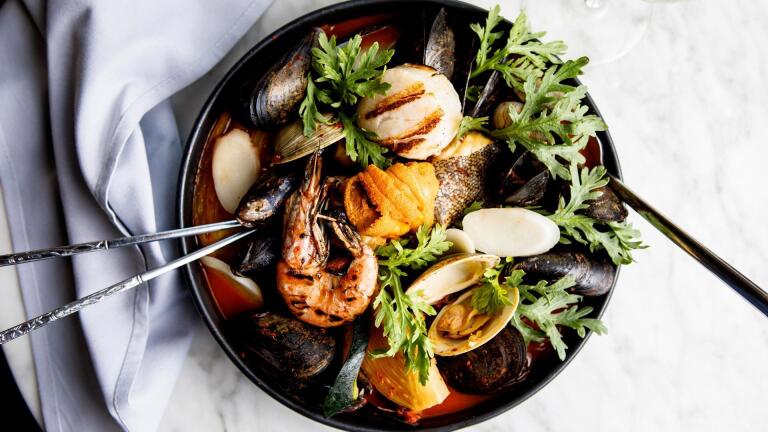The Migrant Kitchen 1-Hour Special
Los Angeles’ booming food scene is being shaped by a new generation of chefs. Visit almost any kitchen in Los Angeles and it is likely you will find a migrant chef combining ethnic cuisines with new flavors and techniques. And often within the food, is a story of their migration.
“The politics of migration, the labor economy, all that drama plays out in the restaurants that we go to,” says journalist and author Rubén Martínez
This is seen even at Los Angeles’ premiere restaurants like Providence (recently named the top restaurant in Los Angeles), where Chef Michael Cimarusti has created one of the most elegant and sought after dining experiences in Los Angeles. Behind his kitchen doors you’ll meet Guatemalan Kitchen Manager Jorge Dugal whose account of struggle and survival is not unlike his peers who left everything behind for a chance to find a better life in the United States. Eleven years ago, he managed to escape from the horrific gang violence and pressure that continues to plague his native Guatemala. Despite all this, he has been able to cling to the better memories he had in Central America and recreate his grandmother’s chirmol sauce from memory, which is now the backbone and inspiration for a spot prawn and chirmol dish on Cimarusti’s prestigious menu.
Jorge Dugal is not alone. In “The Migrant Kitchen” we meet several such chefs whose unique stories of struggle and survival are intricately intertwined with the food they create and serve. Shortly after migrating to the United States, Yong Jun and his mother opened Jun Won, one of Koreatown’s most famed restaurants, frequented on any given night primarily by Korean immigrants along with a handful of food savvy Angelenos. When faced with scrupulous landlords and an unstable lease agreement, however, they struggle to keep their business afloat after twenty-two years. Similarly, street vendor Enrique Peralta, who found his place in Los Angeles’ street food scene selling what critics call some of the cities best chiccarrones, faces the daily threat of being closed down and his equipment being confiscated for illegal street vending. Throughout the uncertainty of the day-to-day, Peralta continues to provide for his family making what Street Gourmet LA’s Bill Esparza deems as artisanal chiccarrones.
Other featured chefs have found food as a way to link back to their cultures while gifting a piece of their tradition to the Los Angeles food community. With her newest venture, Logmeh LA, Chef Deb Michail shares her family’s unique Middle-Eastern cooking traditions to create an experiential dining experience where guests can gather around an open flame and partake in a whole goat roast. Always cooking for a full house, Chef Michail credits the success of Logmeh LA to the knowledge she gained working alongside chefs such as Mozza’s Nancy Silverton to Angelini Osteria’s Gino Angelini. We also meet Claudia Armendariz of Chiles Secos, known to serve the best mole in Los Angeles, whose grandfather opened the stand in Grand Central Market to offer the community a familial sense of home. For many years, the late purveyor and his granddaughter have brought imported Hispanic products, including mole pastes, dried chiles, spices, beans, and grains to the people of Los Angeles.
Across the city, it is not uncommon to find the children of migrants following in their parents footsteps, and using food as a way to stay true to their heritage. Iconic Filipino chef Alvin Cailan, who started Eggslut out of a food truck in a year, is using his success to pave the way for emerging second generation immigrant chefs with his incubator Unit 120. Here you’ll meet Isa Fabro who says her parents never wanted her to speak Filipino, but one thing they always had was the food. The Filipino inspired pastries she creates at Unit 120 link diners with her Filipino heritage. The same can be said for LASA’s Chad and Chase Valencia, who, with a deep knowledge and connection to the historical context of Filipino food, are using the bounty they find here to create California inspired Filipino cuisine.
In each kitchen is a personal story, and in Los Angeles, a city built on immigration, the journeys of migrants are constantly transforming the city’s landscape. By combining customs from their old country with the new, the inhabitants of Los Angeles are forging a new culture unique to the city. It is through this exchange and combination of traditions, according to Martínez, that “great cities are made.”























